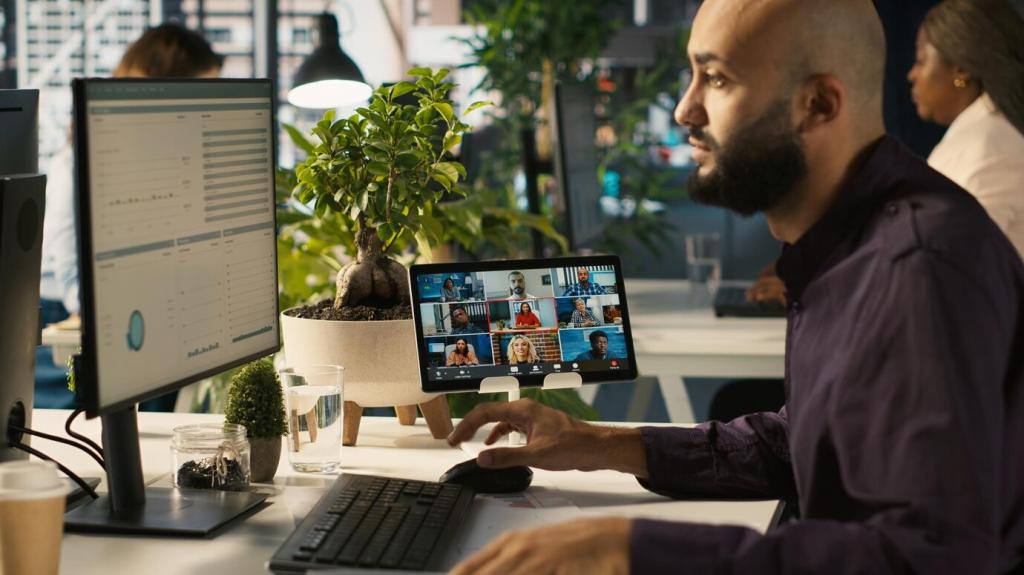Stronger Teams Through Online Collaboration Tools
Map Team Goals to Tool Capabilities
Start by naming collaboration outcomes: quicker decisions, inclusive brainstorming, or visible progress. Then match features like threads, reactions, whiteboards, and async video to those goals. Tell us your must-have features and why they truly matter.
Integrations That Remove Silos
Choose tools that flow into each other: chat linking to tasks, whiteboards embedding into docs, calendars syncing across apps. Reduced context switching frees energy for connection. Comment with your favorite integrations that magically simplify teamwork.
Accessibility and Inclusivity by Design
Prioritize captioned video, readable fonts, keyboard navigation, and mobile parity. When everyone can contribute comfortably, teams bond faster. If accessibility shaped your tool choice, share your story and inspire other readers to follow suit.
Asynchronous Communication That Feels Human
Structured Channels, Organic Conversation
Create clear channels for projects, social chats, and announcements. Encourage emoji check-ins to convey tone. Our marketing team replaced status meetings with thoughtful threads, and morale rose. What channels keep your team aligned without noise?
Threading and Norms to Prevent Overload
Set expectations for reply times, tag usage, and thread summaries. A simple practice of posting a daily recap saved us dozens of pings. Drop your favorite norms that keep async discussions calm and considerate.
Decisions Documented, Context Preserved
Use decision templates in docs and pin outcomes in chat. When a teammate rejoins after leave, they can trace why choices were made. Share how you capture decisions so knowledge endures beyond a single meeting.
Design Jams on Virtual Whiteboards
Use color-coded sticky notes, timers, and silent rounds to surface quieter ideas. After switching to structured FigJam sessions, our design pod doubled contributions from introverts. How do you make brainstorming inclusive and energizing?
Live Editing Without Stepping on Toes
Adopt commenting first, then suggest mode, then commit. Co-authoring guidelines prevent chaos while maintaining flow. We found a simple rule—one editor, many commenters—untangles tense moments. Share your favorite co-editing etiquette below.
Pair Sessions with Shared Cursors
Screen share is good; co-control is better. Shared cursors turn reviews into working sessions. A developer in Manila and a PM in Berlin resolved blockers in minutes. Have a pairing win? Tell us, and help others try it.



Security, Privacy, and Psychological Safety

Permissions That Empower
Default to open access for non-sensitive work while protecting confidential spaces. Clear naming conventions prevent leaks and confusion. What permission model keeps your organization secure without strangling collaboration?

Data Hygiene and Compliance Basics
Review retention policies, guest access, and export rights quarterly. Add training on sensitive data in chat and docs. If you have a checklist that keeps audits smooth, share it so others can adapt it thoughtfully.

Moderation to Keep Spaces Respectful
Set a code of conduct, provide reporting channels, and designate moderators. Psychological safety is a feature, not an accident. Which moderation practices helped your community stay welcoming and productive?
Onboarding and Continuous Learning in the Tool Ecosystem

Create a doc that links to every core space, with short videos on how your team collaborates. Our newest hires say this guide cut ramp-up time dramatically. Would you share your welcome tour template with readers?

Measuring Collaboration Without Killing Joy
Monitor response time ranges, meeting-to-making ratios, and decision latency. We stopped counting messages and started tracking clarity. What humane metrics help you see progress without incentivizing noise or burnout?
Measuring Collaboration Without Killing Joy
Embed monthly sentiment polls in chat with anonymous responses. Pair scores with open questions and themes. If you have a survey that led to a meaningful change, tell us the story and its lasting impact.
